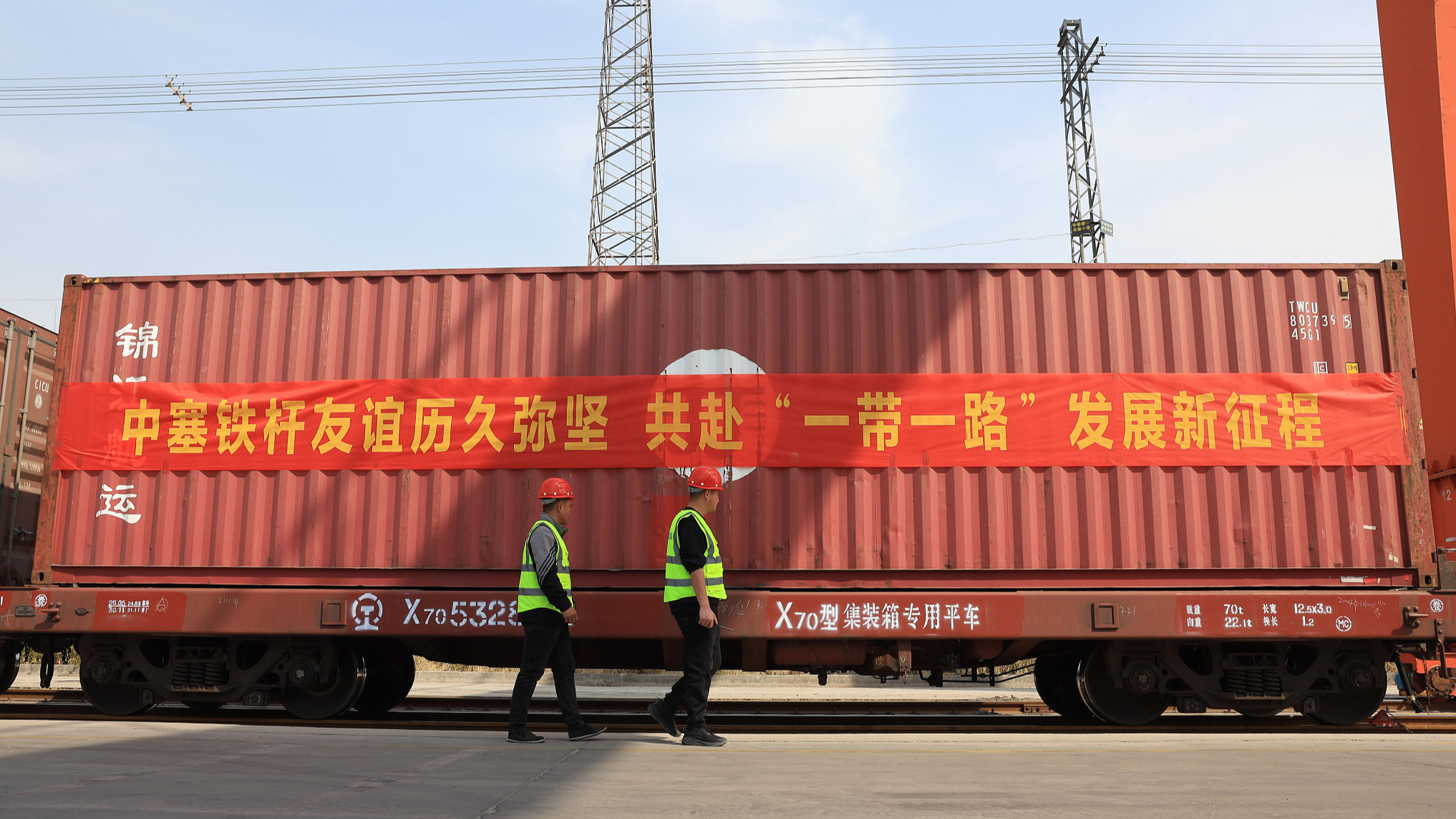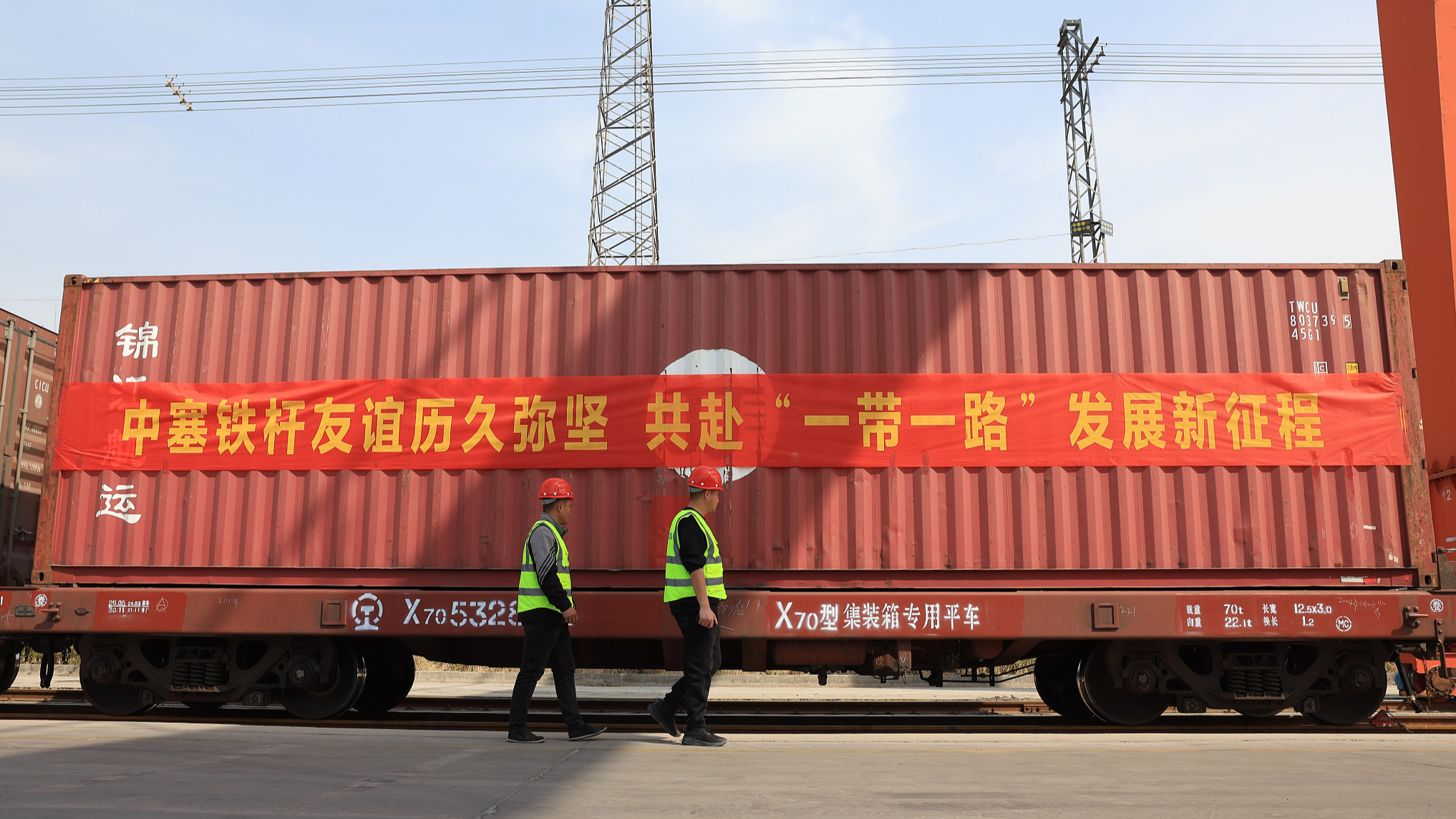 A freight train loaded with containers of goods departs from China’s northern city of Shijiazhuang to the European city of Belgrade, capital of Serbia, March 21, 2024. /CFP
A freight train loaded with containers of goods departs from China’s northern city of Shijiazhuang to the European city of Belgrade, capital of Serbia, March 21, 2024. /CFP
A freight train loaded with containers of goods departs from China’s northern city of Shijiazhuang to the European city of Belgrade, capital of Serbia, March 21, 2024. /CFP
“Iron friends” or “iron brothers” – as strong as metal – this is how Chinese people refer to their closest friends.
The friendship between China and Serbia has been hailed as “ironclad” by Chinese President Xi Jinping, after decades of cooperation and partnership, from the Belt and Road Initiative (BRI) to a free trade agreement (FTA).
Infrastructure connectivity
“Woo-woo” trilled the whistle, as a train arrived at Serbia’s Novi Sad station and was warmly welcomed by locals on March 19, 2022. This marked the official opening of the 80-kilometer-long, Chinese-built Belgrade-Novi Sad high-speed railway.
By March of this year, the railway had transported over 6.83 million passenger trips at speeds of up to 200 kilometers per hour between Serbia’s capital and second-largest city.
The line is also part of the 341-kilometer Belgrade-Budapest railway, a flagship project under the China-proposed BRI. Once completed and operational, travel time between the Serbian and Hungarian capitals will be reduced from 8 hours to approximately 3.5 hours.
When inspecting construction of the railway in 2020, Serbian President Aleksandar Vucic said the rail link would be of immense importance to the living standards of citizens, the flow of goods and China-Serbia relations.
“These are the things that we will remain behind us, revolutionary things that one does not believe in until seeing them,” he added.
As one of the first countries to sign a Memorandum of Understanding on Cooperation on the BRI with China, Serbia was among the very earliest to benefit from an infrastructure partnership.
Besides the railway, the countries have agreed to work together on the construction of highways, expressways, bridges, tunnels, power plants and sewage treatment plants in Serbia.
“Infrastructure connectivity is a prerequisite and a base for the development of each country,” Maja Stefanovic, Serbian ambassador to China, wrote in an article published in People’s Daily.
She noted that the results of Serbia’s engagement in the BRI over the past decade can be seen in numerous projects, adding the participation of Serbia in the implementation of the BRI has contributed to greater awareness of Serbia’s potential.
A symbolic steel gift
Among the collection of gifts that President Xi has received from foreign friends, a rounded plaque made of steel symbolizes the ironclad friendship between China and Serbia.
The commemorative plaque was tailor-made by workers at the Smederevo Steel Mill using its own steel and was presented to Xi during his visit to the factory in 2016.
With a history dating back to 1913, the Smederevo Steel Mill is Serbia’s largest such factory. It was seen as the “pride of Serbia” in its glory days. However, after the 1990s, fierce market competition and management problems plunged the steel mill into the verge of bankruptcy.
In 2016, China’s HBIS Group purchased the mill for 46 million euros (about $48.64 million) under the BRI. By 2018, quality steel products had been transported from the mill to over 30 countries and regions, and by 2020, it had become Serbia’s leading exporter for three consecutive years.
“Now Chinese and Serbian businesses have joined hands to usher in new chapters in industrial capacity cooperation between our two countries,” Xi said during his visit to the factory. “This has not only carried forward our traditional friendship, but also demonstrated our resolve to deepen reform and achieve win-win results.”
The win-win results can be seen in all areas of cooperation between the two countries. The bilateral trade volume amounted to $3.55 billion in 2022, up 10.1 percent year on year, according to data from China’s General Administration of Customs.
Last October, China and Serbia signed an FTA in Beijing, the first China has inked with a Central or Eastern European country. Speaking to CGTN, Vucic said he had dreamed of the agreement, and he believes it will open doors for Serbia and bring opportunities to both sides.
Over the last 10 years, Chinese investment in Serbia has increased 60-fold, and it is now the second-largest investor in the country. In 2019, Serbia officially became a non-regional member of the Asian Infrastructure Investment Bank, the China-initiated multilateral financial institution.
The two countries have launched direct flights and also signed a mutual-recognition driving license deal and mutual visa-free agreement, which facilitate the flow of people and create more opportunities for cooperation in tourism.
